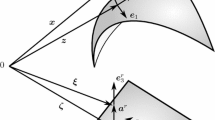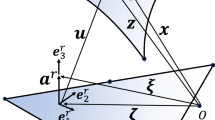Summary
A nonlinear shell theory, including transverse strains perpendicular to the shell midsurface, as well as transverse shear strains, with exact description of the kinematical fields, is developed. The strain measures are derived by considering theGreen strain tensor of the three-dimensional shell body. A quadratic displacement field over the shell thickness is considered. Altogether seven kinematical fields are incorporated in the formulation. The kinematics of the shell normal is described by means of a difference vector, avoiding the use of a rotation tensor and resulting in a configuration space, where the structure of a linear vector space is preserved. In the case of linear constitutive equations, a possible consistent reduction to six degrees of freedom is discussed. The finite element formulation is based on a hybrid variational principle. The accuracy of the theory and its wide range of applicability is demonstrated by several examples. Comparison with results based on shell theories formulated by means of a rotation tensor are included.
Similar content being viewed by others
References
Andelfinger, U.;Ramm, E.: EAS-elements for 2D-, 3D-, plate and shell structures and their equivalence to HR-elements. Int. J. Num. Meth. Eng.36 (1993) 1311–1337
Basar, Y.: A consistent theory of geometrically non-linear shells with an independent rotation vector. Int. J. Solids Struct.23 (1987) 1401–1415
Bathe, K. J.;Dvorkin, E.: A four-node plate bending element based on Mindlin/Reissner plate theory and a mixed interpolation. Int. J. Num. Meth. Eng.21 (1985) 367–383
Baumann, M.;Schweizerhof, K.;Andrussow, S.; An efficient mixed hybrid 4-node shell element with assumed stresses for membrane, bending and shear parts. Eng. Comput.11 (1994) 69–80
Büchter, N; Ramm, E.; Roehl, D.: Three-dimensional extension of nonlinear shell formulation based on the enhanced assumed strain concept. (accepted for publication in Int. J. Num. Meth. Eng.)
Chroscielewski, J.;Makowski, J.;Stumpf, H.: Genuinely resultant shell finite elements accounting for geometric and material nonlinearity. Int. J. Num. Meth. Eng.35 (1992) 63–94
Curtis, M. L.: Matrix groups. Berlin: Springer 1984
Gruttman, F.;Stein, E.;Wriggers, P.: Theory and numerics of thin elastic shells with finite rotations. Ing. Arch.59 (1989) 54–67
Huang, H. C.;Hinton, E.: A new nine node degenerated shell element with enhanced membrane and shear interpolation. Int. J. Num. Meth. Eng.22 (1986) 73–92
Jang, J.;Pinsky, P. M.: An assumed covariant strain based 9-node shell element. Int. J. Num. Meth. Eng.24 (1987) 2389–2411
Krätzig, W. B.;Basar, Y.;Wittek, U.: Nonlinear behaviour and elastic stability of shells. In: Ramm, E. (ed.) Buckling of Shells. Berlin: Springer 1984
Kühhorn, A.;Schoop, H.: A nonlinear theory of sandwich shells including the wrinkling phenomenon. Arch. Appl. Mech.62 (1992) 413–427
Marsden, J. E.;Hughes, T. J. R.: Mathematical foundations of elasticity. Englewood Cliffs: Prentice-Hall 1983
Naghdi, P. M.: The theory of shells. In: Flügge, S. (ed.) Handbuch der Physik VI/2. Berlin: Springer 1972
Park, K. C.;Stanley, G. M.: A curvedC O shell element based on assumed natural-coordinate strain. Trans. ASME J. Appl. Mech.53 (1986) 278–290
Pian, T. H. H.;Sumihara, K.: Rational approach for assumed stress finite elements. Int. J. Num. Meth. Eng.20 (1984) 1685–1695
Sansour, C.;Bednarczyk, H.: Shells at finite rotations with drilling degrees of freedom, theory and finite element formulation. In: Glowinski, R. (ed.) Computing Methods in Applied Sciences and Engineering, pp. 163–173. New York: Nova Sci. Publisher 1991
Sansour, C.; Bednarczyk, H.: The Cosserat surface as a shell model, theory and finite-element formulation. (accepted for publication in Comp. Meth. Appl. Mech. Eng.)
Sansour, C.;Bufler, H.: An exact finite rotation shell theory, its mixed variational formulation, and its finite element implementation. Int. J. Num. Meth. Eng.29 (1992) 73–115
Schieck, B.;Pietraszkiewics, W.;Stumpf, H.: Theory and numerical analysis of shells undergoing large elastic strains. Int. J. Solids Struct.29 (1992) 689–709
Simo, J. C.;Fox, D. D.: On a stress resultant geometrically exact shell model, Part I: Formulation and optimal parametrization. Comput. Meths. Appl. Mech. Eng.72 (1989) 267–304
Simo, J. C.;Fox, D. D.;Rifai, S.: On a stress resultant geometrically exact shell model, Part IV: Variable thickness shells with through-the-thickness stretching. Comput. Meths. Appl. Mech. Eng.81 (1990) 53–91
Zienkiewicz, O. C.: The Finite Element Method. New York: McGraw-Hill 1978
Author information
Authors and Affiliations
Additional information
Dedicated to Prof. Franz G. Kollmann, on the occasion of his 60th birthday
Rights and permissions
About this article
Cite this article
Sansour, C. A theory and finite element formulation of shells at finite deformations involving thickness change: Circumventing the use of a rotation tensor. Arch. Appl. Mech. 65, 194–216 (1995). https://doi.org/10.1007/BF00799298
Received:
Accepted:
Issue Date:
DOI: https://doi.org/10.1007/BF00799298




